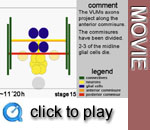Two commissures develop in each neuromere,
except the last (a9) neuromere which has only one commissure. Formation
of the supraoesophageal and frontal commissures is delayed with respect
to the commissures of the ventral cord, and they do not become evident
until about 1 h after germ band shortening. Formally, all commissural
growth cones have to perform a similar task, in fly as well as in man,
as they grow towards and across the midline. Initially they have to show
high affinity for cells located at the midline as they grow straight towards
these cells. However, as soon as they have reached the midline they must
loose their affinity for these cells, since they are now able to cross
them and follow longitudinal axon tracts, which they had ignored on the
ipsilateral side. This formal dissection of commissure formation implies
general functions of midline cells during the attraction of commissural
growth cones and their guidance across the midline.
 After
the specification of the midline cells the pioneers of the posterior commissure
grow towards the anterior VUM neurons. Subsequently, the pair of MP1 neurons
moves out of the midline to a more ventral and lateral position. The VUMs
move slightly anteriorly and ventrally. When the growth cones of the posterior
commissures reach the anterior VUM neurons they grow anteriorly around
these cells. Once the posterior commissure is formed (note that the growth
cones do not stop at the midline as it might look in the movie, they pass
the midline and extend into the contralateral PNS or the connectives),
the midline glial cells start to migrate posteriorly, coming into a position
where they might serve as attractive intermediate target for the growth
cones establishing the anterior commissure.The axons that pioneer the
anterior commissure are initially found in close association with the
posterior commissure. Only the growth cones of the VUM neurons separate
the commissures. Subsequently, the posteriorly moving cell bodies of the
MGA midline glia squeeze in between the two commissures, thereby forcing
them apart. The intercalating migration of the two most posteriroly midline
glial cells brings the two commissures into their final ladder like organisation.
The initial 6 midline glia cells per metamer are reduced to 3-4 by apoptosis.
After
the specification of the midline cells the pioneers of the posterior commissure
grow towards the anterior VUM neurons. Subsequently, the pair of MP1 neurons
moves out of the midline to a more ventral and lateral position. The VUMs
move slightly anteriorly and ventrally. When the growth cones of the posterior
commissures reach the anterior VUM neurons they grow anteriorly around
these cells. Once the posterior commissure is formed (note that the growth
cones do not stop at the midline as it might look in the movie, they pass
the midline and extend into the contralateral PNS or the connectives),
the midline glial cells start to migrate posteriorly, coming into a position
where they might serve as attractive intermediate target for the growth
cones establishing the anterior commissure.The axons that pioneer the
anterior commissure are initially found in close association with the
posterior commissure. Only the growth cones of the VUM neurons separate
the commissures. Subsequently, the posteriorly moving cell bodies of the
MGA midline glia squeeze in between the two commissures, thereby forcing
them apart. The intercalating migration of the two most posteriroly midline
glial cells brings the two commissures into their final ladder like organisation.
The initial 6 midline glia cells per metamer are reduced to 3-4 by apoptosis.
Media list